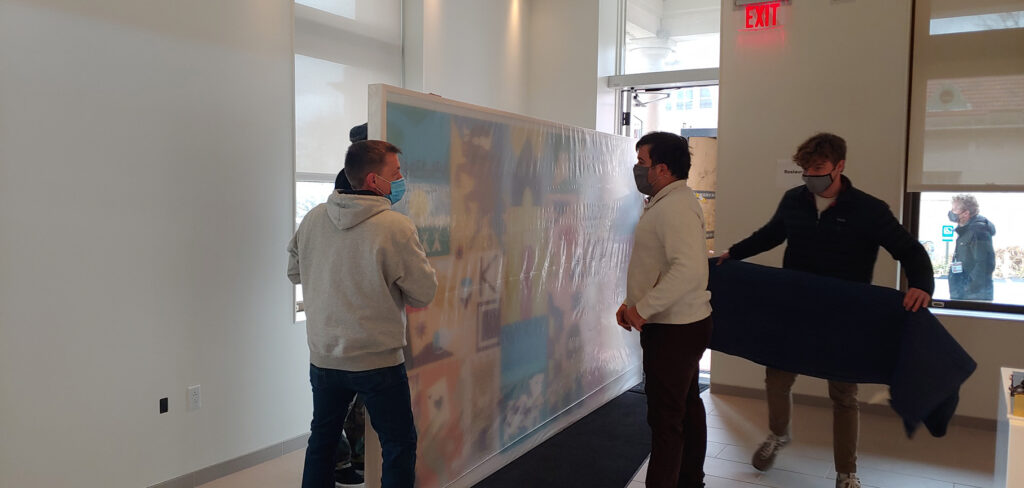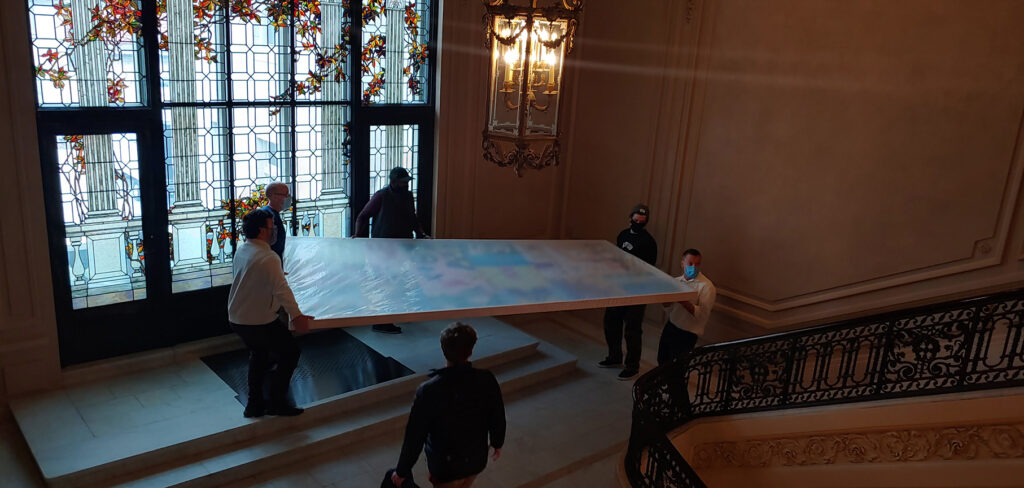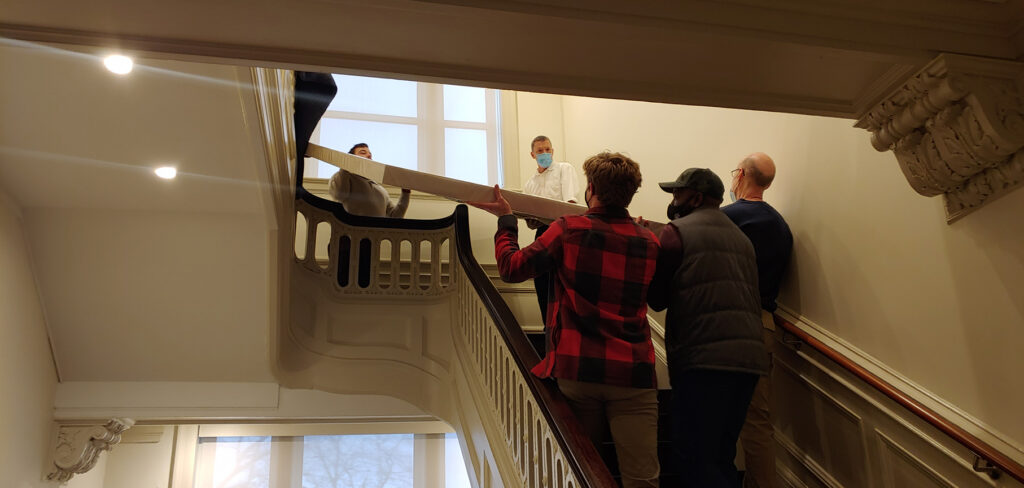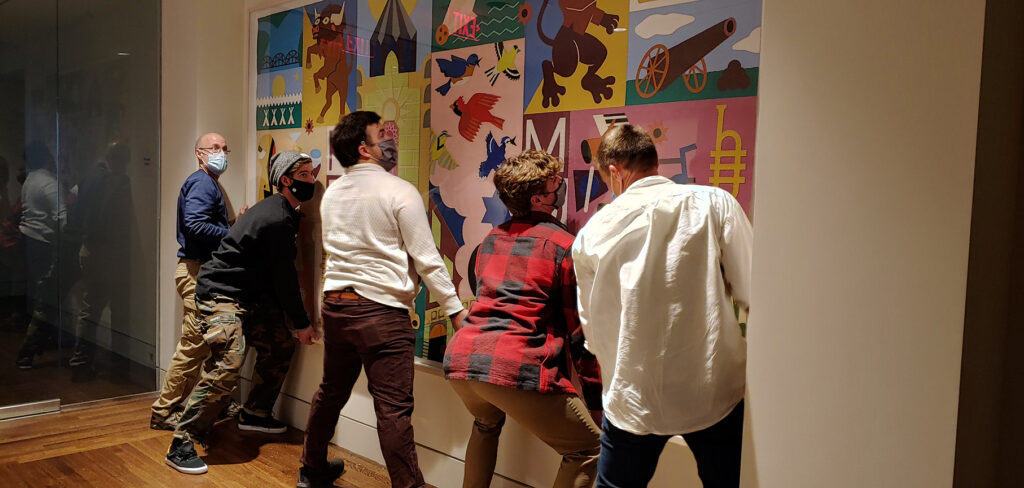Nikki Lansford
Editorial Assistant
The Kansas City Museum is one step closer to its grand reopening as the first piece of permanent artwork was installed into the building since renovations to the property began in 2017.
The piece, titled “The Battle of Kansas City,” is a mixed element creation of both a collage and quilt-making technique created by partially blind and colorblind artist Stephen Proski.
Proski is one of three local Kansas City artists who was given the opportunity to have his art displayed in the museum through the “One Percent for Art Program.” The program sets aside one percent of public construction funds for public art enhancements. The Municipal Art Commission approves all artwork commissioned by this program.
After a friend informed Proski of the potential opportunity to have his art on display at the museum, Proski then applied and was chosen as one of the featured artists for the program.
Proski’s colorful art piece consists of compositions, which are cut into pieces and sewn back together by hand to create remixed arrangements of past and present moments, reflecting the whimsy and absurdity of our post-cultural landscape.
Proski said the piece not only depicts the history of Kansas City, but is also a reflection on his own personal experience with the city.
“I spent a long time here, a lot longer than I thought I was going to be here, so it’s kind of me captured in that experience,” Proski said.
As part of his personal experience, Proski’s art reflects how he sees the world as someone who is visually impaired. Proski said he has to reshape and reorganize things around him in order for it to make sense to him visually.
“For instance, a field of flowers is very chaotic with a lot of detail and color and different shades of color, and a lot of colors that I can’t see, so me trying to make sense of that is me trying to make simple shapes and just simplify as much as possible,” Proski said.
Born in Arizona, he has come to call Kansas City his home after studying at the Kansas City Art Institute (KCAI) and living in the city for 10 years. He wanted the art piece to not only speak to locals, but all those who will view it.
“I want the viewer to feel something as opposed to just being an aesthetically pleasing image… and having nothing to do or know about Kansas City, I think you can still achieve that,” Proski said.
The project took about eight months to complete, Proski said.
“I’m really excited to work with the artist to see what programs we do around that piece,” said Director of Programs and Events Paul Gutierrez.
For Proski, he said, the opportunity to have his work displayed at the museum is a big deal for it is not only his first exam piece from KCAI, but also the largest he has created.
The 72” by 132” creation was framed by Dolphin Frame in Kansas City and delivered to the Kansas City Museum on the afternoon of Thursday, Jan. 14, by Paul Churchill, the founder of Monarch Fine Art Services, and his crew.
Upon their arrival, the difficult task of getting the large piece of art to the third floor of the building began. With tight turns throughout the building and the heavy frame enclosing the artwork, it took all of Churchill’s team to get Proski’s work to the top floor.
“It was very, very challenging to get it up the second flight of stairs on the west stair,” said Kansas City Museum Executive Director Anna Marie Tutera. “I was incredibly nervous.”
After several hours of transporting, maneuvering and mounting, the piece of art is now mounted proudly in the middle section of the museum’s third floor for all to see when the building reopens.
“I think it’s a perfect little spot, and it’s a nice place to highlight it,” Churchill said.
Proski’s work will be surrounded by three main exhibit galleries on that floor; a theater, which used to house the famous igloo; and a story sharing place that will be used to experience oral histories.
His new art installation is just one of the many changes and additions to the Kansas City Museum, also known as Corinthian Hall.
The museum, located at 3218 Gladstone Blvd., is undergoing a $20 million renovation and restoration project. The building, a former residence built by lumber baron Robert Alexander (R.A.) Long in 1910, will look vastly different by time the work is completed.
With new additions, such as interactive touch screen displays, the museum will be a place where Kansas City can display its art and history in the classic mansion with some modern day technology.
The Kansas City Museum renovation is slated for completion this year, with a reopening date in late summer 2021.





















